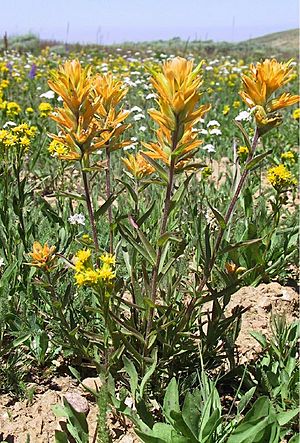Christ's Indian paintbrush facts for kids
Quick facts for kids Christ's Indian paintbrush |
|
|---|---|
 |
|
| Conservation status | |
| Scientific classification | |
| Genus: |
Castilleja
|
| Species: |
christii
|
Castilleja christii is a very special and rare flowering plant. It is often called Christ's Indian paintbrush because its flowers look like paintbrushes. This plant is found only in one place in the entire world! That place is Mount Harrison in Idaho, United States. It is one of the rarest plants in Idaho.
What Does Christ's Indian Paintbrush Look Like?
This plant was named after John Henry Christ. He was the first person to collect it in 1973. It is a perennial herb. This means it lives for more than two years. It has several straight stems. They grow about 15 to 30 centimeters (6 to 12 inches) tall.
Its leaves are shaped like a spear. They are a few centimeters long. Sometimes, these leaves can be divided into smaller parts. The plant's flower cluster is covered in tiny, sticky hairs. It has many yellow or orange parts called bracts. These bracts look like leaves but are part of the flower. The actual flowers are about 2 to 3 centimeters (0.8 to 1.2 inches) long. Christ's Indian paintbrush blooms in July and August. It makes new plants from seeds.
Where Does This Rare Plant Live?
This unique plant grows near the top of Mount Harrison. It lives at a high elevation, about 2,774 meters (9,100 feet) above sea level. This area gets a lot of deep snow. Sometimes, the snow stays on the ground all year long!
The plant grows in grassy meadows. It shares its home with other plants like Festuca idahoensis and Elymus trachycaulus. It also likes snowy areas with plants such as Solidago multiradiata and Lupinus argenteus. The climate there is subalpine. This means it is like a mountain forest, but without many trees. The soil is not very deep in these areas.
Protecting Christ's Indian Paintbrush
The only group of these plants is looked after by the Sawtooth National Forest. The number of plants changes a lot each year. Sometimes there are over a million plants! But overall, the total number is slowly going down.
The biggest danger to this plant is losing its home. This happens when new roads are built in the area. Some vehicles also drive off the roads, even though there are barriers to stop them. This can damage the plants.
Cows sometimes graze in the plant's habitat. However, fences protect some parts of the area from grazing. Another problem is a plant called smooth brome (Bromus inermis). This plant was brought into the area by accident. It is a noxious weed, which means it grows fast and can harm other plants. Efforts are being made to protect this special and rare plant.


